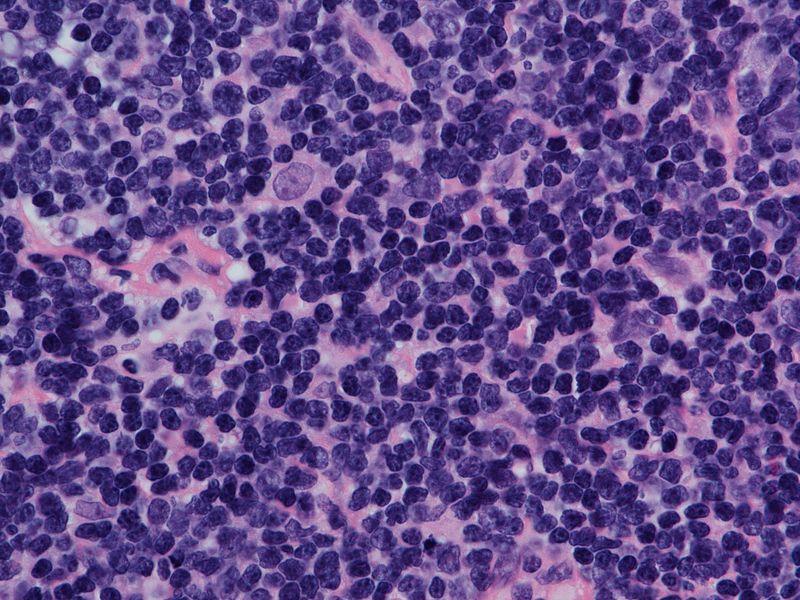Acalabrutinib Combo Shows Promising Outcomes in Mantle Cell Lymphoma
Overall survival rates at 12 and 36 months appear to favor the addition of acalabrutinib to bendamustine and rituximab in the treatment of those with mantle cell lymphoma in a phase 1b trial.
“These results support the ongoing phase 3 trial called ECHO [NCT02972840], which is comparing ABR vs bendamustine [and] rituximab as frontline treatment in patients with MCL,” Tycel Phillips, MD, assistant professor in the division of hematology and oncology at the University of Michigan Comprehensive Cancer Center, said.

Acalabrutinib (Calquence) plus bendamustine (Treanda) and rituximab (Rituxan) produced promising outcomes and tolerability in patients with treatment-naive (TN) or relapsed/refractory (R/R) mantle cell lymphoma (MCL), according to results from a phase 1b trial (NCT02717624) presented at the 2023 European Hematology Association (EHA) Congress.
Across 3 countries, 38 patients with MCL were enrolled in the study, with 18 patients being TN and 20 patients having R/R disease. At the time of data cutoff on June 15, 2022, median follow-up was 47.6 months (range, 0.6-72.4) in the TN cohort and 20.4 months (range, 1.2-64.2) in the R/R cohort. Fourteen of the patients (78.8%) in the TN cohort completed the first 6 cycles of the triplet therapy compared with 10 (50.0%) in the R/R cohort before continuing acalabrutinib maintenance therapy.
Among these patients, the overall response rate (ORR), based on Lugano criteria and PET-CT alone, was 94.4% in the TN cohort compared with 85.0% in the R/R cohort. Further, based on the Lugano criteria, a complete response (CR) rate of 77.8% was seen in the TN cohort and 70.0% in the R/R cohort, compared with a CR rate observed on PET/CT alone of 88.9% vs 80.0% in the TN and R/R cohorts, respectively.
While a median duration of response (DOR) was not reached in the TN cohort, the median DOR was 43.5 months in the R/R cohort. A median time to initial response of 1.9 months was observed in the TN cohort with a best response of 2.1 months, which was similar to the R/R cohort at 1.9 months and 2.3 months, respectively. Moreover, median progression-free-survival (PFS) was not reached in the in the TN cohort but was 28.6 months in the R/R cohort, respectively (95% CI, 11.8 to not estimable [NE]). The PFS rates at 12 months and 36 months were promising for patients on the triplet therapy in the TN cohort at 88.5% (95% CI, 61.4%-97.0%) and 68.1% (95% CI, 39.2%-85.4%), respectively, and in the R/R cohort at 73.0% (95% CI, 46.7%-87.8%) and 47.3% (95% CI, 22.6%-68.6%), respectively.
According to Tycel Phillips, MD, who presented these data at the EHA 2023 Congress in a poster session, a median overall survival (OS) was also not reached in either cohort, but OS rates at 12 and 36 months still favored the addition of acalabrutinib. For TN patients, the OS rate at 12 months was 88.9% (95% CI, 62.4%-97.1%) and 74.6% (95% CI, 45.0%-89.8%) at 36 months. Again, favorable rates were seen in the R/R cohort with an OS rate of 88.7% (95% CI, 61.4%-97.1%) at 12 months and 69.7% (95% CI, 41.5%-86.2%) at 36 months.
For the phase 1b trial, these data also met prespecified safety and tolerability end points with the addition of acalabrutinib to the chemotherapy and immunotherapy combination. The most common cause for discontinuation of acalabrutinib was adverse events (AEs) in both the TN and R/R cohort at 33.3% and 45.0%, respectively. However, 10 patient still remained on acalabrutinib at the time of data cutoff. Ten patients in total on the trial died, with 1 due to disease progression in the R/R cohort and 6 due to reasons classified as other, but the primary cause of death was either unknown or due to an AE in these patients.
Looking at AEs of clinical interest, the most common AE of any grade in both groups included neutropenia (60.5%), infections (73.7%), hemorrhage (36.8%), and cardiac events (21.1%). Other AEs of interest that were not common but notable included 6 patients that developed a second primary malignancy of any grade, which 3 of these malignancies were not skin cancer.
Among all patients, the most common grade 1/2 treatment-emergent AEs (TEAEs) included nausea (57.9%), fatigue (50%), cough (50%), headache (39.5%), diarrhea (36.8%), upper respiratory tract infection (42.1%), and vomitting (42.1%). Among these TEAEs the most common grade 3/4 TEAEs in both groups was neutropenia (44.7%) with 50% of patients in the R/R group experiencing it compared with 38.9% in the TN cohort, which made up all the patients with neutropenia in the TN cohort.
Between the 2 cohorts, patients who were TN experienced more vomiting of any grade (55.6%) compared with R/R patients (30%), along with fatigue (72.2% vs 35%), and headache (61.1% vs 20%). Moreover, more patients in the TN cohort experienced grade 1/2 pyrexia and arthralgia at 38.9% and 27.8%, respectively, compared with 15% and 5% in the R/R cohort.
“These results support the ongoing phase 3 trial called ECHO [NCT02972840], which is comparing ABR vs bendamustine [and] rituximab as frontline treatment in patients with MCL,” concluded Phillips, assistant professor in the division of hematology and oncology at the University of Michigan Comprehensive Cancer Center.
The phase 3 trial has an estimated enrollment of 546 patients with an estimated study completion data of February 2024, looking at a primary end point of PFS as defined by Lugano classificiation.
Reference
Phillips T, Wang M, Robak T, et al. Safety and efficacy of acalabrutinib, bendamustine, and rituximab in patients with treatment-naive or relpased/refractory mantle cell lymphoma: phase 1b trial. Presented at: 2023 European Hematology Association Congress; June 9-11, 2023; Frankfurt, Germany. Abstract P1094.